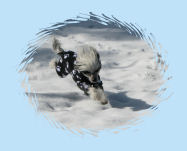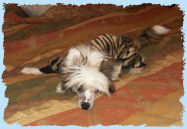
|
|
|

|

|
|
|
|
|
The Chinese Crested is an old oriental breed, with written history dating back to the 13th century in China.
Yet, there is much controversy about exactly where this breed originated as there were hairless dogs found in
Africa, Mexico and in Central and South America in the 1500s. So it's unknown whether the Chinese got the dog
from Mexico or brought the dog with them and traded with the Indians of Mexico.
It is thought that the Chinese Crested dog was kept on board the Chinese fishing ships to control vermin, and/or
they were a food source. It is also speculated that the hairless dogs were given to Royal Families as they would
be content to sit on Elder's body giving them comfort through the heat that generated from their hairless
bodies.
What is known is that the first Chinese Crested dogs were brought to Great Britain as part of a zoological show.
The first Chinese Crested was registered in Great Britain in 1881. In 1880, a New Yorker, Ida Garrett, became
interested in the breed; exhibiting, breeding and writing about the Chinese Crested for over sixty years. Mrs. Garrett
shared her enthusiasm for the breed with a long-time friend Debra Woods. For nearly 40 years the two ladies worked
together to promote the breed in the United States. In 1979 the American Chinese Crested Club was founded. In 1991
the breed was recognized by the American Kennel Club (AKC).
The additional promotion of the Chinese Crested worldwide was by the American singer, dancer and entertainer, Gypsy
Rose Lee. Her sister rescued a Chinese Crested dog from a Connecticut animal shelter and had given it to Ms. Lee.
Ms. Lee was so taken with the breed; she became a breeder and protector of the Chinese Crested. It is to be noted
that most active Crested kennels in the world can trace the ancestry of their dogs to the Crest Haven (Debra Woods)
and Lee lines.
The standard for the breed is 11 to 13 inches at the shoulders, but you will find dogs slightly smaller or larger. Weight will vary depending on the size of the dog. Both breeds can come in any variation of colors and spots. Not always will an adult be the same color as when it was a puppy as the coat color can experience shade changes.
The breed comes in two coat varieties referred to as the "hairless" and the "powderpuff". The hairless will only have hair on their head (Crest), feet (Socks) and tail (Plume) with the rest of their body being hairless. However, there can be variations here too. A hairless can be a "Hairy Hairless", meaning the body can exhibit a short, thin coat covering the entire body, or a "True Hairless", meaning minimal to no body hair. The powderpuff has hair covering their entire body with a double, straight, soft, silky coat. The face and ears on both varieties can be shaved depending on the preference of the owner.
The personality of the breed is to be comical, lively, intelligent and affectionate, with cat-like tendencies (sitting in high places and using their paws to grab). As with all dogs, Cresteds should be well socialized to avoid shyness or fear of the unknown. Their medium to high activity level combined with their outgoing enthusiasm makes them excellent candidates for all types of performance training. They excel at agility, obedience, rally, and lure coursing. Their intelligent and affectionate personalities also make them great therapy dogs.
With each variety there is grooming. While the Crested is not the typical "shedding" breed, they will lose hair from breakage and/or during grooming. The hairless may need to be bathed more often to keep the skin clear, using lotions (without lanolin) to keep it supple, and sun block to avoid sun burns on the lighter colored Cresteds. Naturally, extreme temperatures should be taken into consideration with a hairless and clothing (without wool) is something the hairless enjoys. The powderpuff will also need routine bathing and brushing to maintain a healthy coat. Again, avoid products with lanolin as some Cresteds may have a reaction to it. Toy breeds are notorious for having poor teeth, but if you brush your Crested's teeth regularly you can maintain good dental health. Toenails should be trimmed to a moderate length.
Cresteds are considered hypoallergenic because they have hair not fur. To be "Hypoallergenic" is to have a decreased tendency to cause allergies. There is no such thing as a non-allergenic dog. Hypoallergenic dog breeds will still produce allergens, but because of their coat type will typically produce less than others. People with severe allergies or asthma need to spend time with any breed in order to determine if they will be affected.
The Chinese Crested can live up to 15 years or longer. They have very few health problems, but there are some
health issues of which you should be aware.
PRA - Progressive Retinal Atrophy is a slow progressive hereditary disease which causes retinal
dysplasia or degeneration. The age of onset of clinical signs varies, but the endpoint is blindness. Genetic
testing can be done to detect the presence of one form of PRA known as prcd-PRA. Visit www.optigen.com for more information about the disease and the available tests.
PLL - Primary Lens Luxation is a hereditary disease in Chinese Cresteds. It causes the lens of the
eye to become partially dislocated (Lens Subluxation) or fully dislocated (Lens Luxation) from its normal position.
This dislocation causes movement of the lens forward
through the pupil or backwards into the Vitreous Chamber of the eye and requires immediate veterinary attention. The
displaced lens may be removed to prevent painful secondary glaucoma, and sometimes loss of vision. Genetic testing
is available to identify the genes that cause the disease. Visit www.offa.org/dnatesting/index.html for more information about the disease and the available tests.
Patellar Luxation - The patella (kneecap) is a small bone which guards the knee joint. The patella sits
in a grove in the femur, and is held in place by a combination of ligaments and muscles. This bone can slip out of position
due to injury, poor alignment, weak ligaments, an insufficient groove in the femur. Generally, the dog will limp, carry
the leg off the ground, or hop when running. If the problem is severe it can necessitate surgery. Patellar luxation can
be either hereditary or due to injury. Cresteds should be examined by a veterinarian to ensure the patellas are properly
placed before they are used in a breeding program or doing performance events.
Dry Eye is a condition caused by the lack of tear production. This can be due to lack of nerve stimulation
of the tear glands, failure of the tear glands, or blockage of the ducts that carry the tears to the eyes. Full diagnosis
can only be performed by a veterinarian to determine the cause. Treatment will be dependent on the cause and severity of the
condition, but often involves using ointment and/or drops several times a day to keep the dog comfortable and to keep the
cornea moist.
Teeth - The hairless Crested may never develop full dentition and/or may lose some of their adult teeth.
The genetic information for the dentition appears to be linked to the hairless gene. This causes the hairless to have
short-rooted teeth which can be more easily lost. Regular cleaning and checkups by your veterinarian usually preserves
the teeth for a longer period of time. Since the powderpuff doesn't carry the hairless gene, they should have normal,
full dentition.
Vaccines - As with all small dogs, care should be given when vaccinating a Chinese Crested. It is prudent
not to give all vaccines at once to such a small dog. A vaccine called Leptospirosis may cause some side effects, so should
be given only if needed. The Leptospirosis disease is transmitted to dogs by the urine of an infected raccoon, cow, horse,
dog or rat. Most small dogs are not exposed to the urine of wild animals and farm animals, so it is usually not a required vaccine.
If you have any questions about the breed, please contact us at: info@tarheelchinesecrestedclub.org.